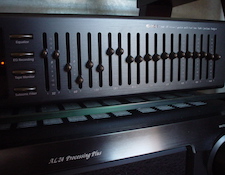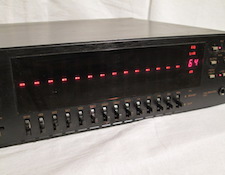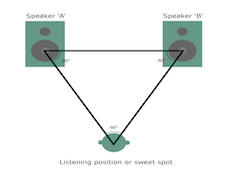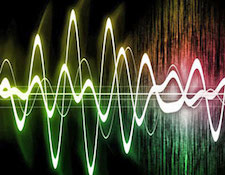It’s the time of year for saving money!
Last time, in Part 7 of this continuing series, after the usual short summary of what had gone before, I wrote about digital crossovers, and how they could not only provide “phase-perfect” reproduction from our speakers, but could also be used to equalize them to be “frequency-perfect”, as well. The only potential problem with using digital circuitry to separate the various frequency ranges, correct them, and send them to the appropriate drivers, I wrote, was that doing so could require buying not only the digital device, but also bi- or tri-amping your system. (Using one amplifier per section to drive your speakers’ woofer(s), tweeter(s), and midrange driver(s), if any) Instead of that, I asked at the article’s end, “…why not just correct the entire system and even the room that it plays in all at the same time?”
 Back in what was probably the mid-1990s, I bought an Audio Control C-101 “octave equalizer with real-time spectrum analyzer and pink noise generator”. That was an analog device that would allow you to run “pink noise” (random noise filtered to always have an equal amount of signal energy in every octave of the audio range) through your system and, using the calibrated microphone that came with it, measure the actual sound level at every octave in your listening room so that, if there were “peaks or valleys”, you could use its built-in equalizer to apply a boost or cut as necessary in each of the available one-octave frequency ranges and correct them to the “flat” or whatever other frequency response you desired. (An “octave”, incidentally, is a doubling or halving of any starting frequency. In audio, we often talk about the octave between 20 and 40 Hz, for example, or from 1kHz to 2kHz, or 10kHz to 20kHz. On the C-101, the “bottom” octave is from 32Hz to 64Hz.)
Back in what was probably the mid-1990s, I bought an Audio Control C-101 “octave equalizer with real-time spectrum analyzer and pink noise generator”. That was an analog device that would allow you to run “pink noise” (random noise filtered to always have an equal amount of signal energy in every octave of the audio range) through your system and, using the calibrated microphone that came with it, measure the actual sound level at every octave in your listening room so that, if there were “peaks or valleys”, you could use its built-in equalizer to apply a boost or cut as necessary in each of the available one-octave frequency ranges and correct them to the “flat” or whatever other frequency response you desired. (An “octave”, incidentally, is a doubling or halving of any starting frequency. In audio, we often talk about the octave between 20 and 40 Hz, for example, or from 1kHz to 2kHz, or 10kHz to 20kHz. On the C-101, the “bottom” octave is from 32Hz to 64Hz.)
My C-101 worked great for what it was. I still have and use it, and highly recommend Audio Control, the company that built it, as great people who build great stuff and fully support their products even after more than twenty years. The C-101 DOES, however, have its limitations, especially as compared to more modern products: For one thing, the fact that it only breaks the frequency spectrum into octaves instead of having a more useful 1/3 octave or “parametric” (variable frequency and variable bandwidth) topology makes using it somewhat akin to slicing a cake with a shovel and limits its applicability for making the finest adjustments. The same thing applies to its “real time analyzer” section which also reads-out octaves, only.
 Somewhat later devices, like the dbx 14/10, while largely the same thing in basic concept – a pink noise generator to provide a test signal, a real-time analyzer to display the sound, and a graphic equalizer to make corrections, did it automatically, and could even store settings for later use or average a number of settings at will. They were still analog, however, and still, therefore, had problems of time-delay and related phase-shift.
Somewhat later devices, like the dbx 14/10, while largely the same thing in basic concept – a pink noise generator to provide a test signal, a real-time analyzer to display the sound, and a graphic equalizer to make corrections, did it automatically, and could even store settings for later use or average a number of settings at will. They were still analog, however, and still, therefore, had problems of time-delay and related phase-shift.
What’s happened in the last few years, however is that a plethora of new DSP (digital signal processing) products, both separate hardware devices, additions to existing receivers and electronics, and software applications that you can use on your own computer, have appeared that promise hitherto unheard-of sonic wonders. “Ruler-flat frequency response (or whatever else you may desire) as the result of phase perfect digital equalization and the elimination of (bass frequency) “room nodes” are just some of the things that they offer and comments about the listening improvements they can provide abound, both from owners and even the most respected reviewers.
I have my doubts, though, about any system that claims to offer perfection (or even near-perfection) of all kinds in all parts of the listening room. For one thing, what we hear at any given listening position in any room will always consist of both direct and reflected sound, in varying proportion depending on the size, shape, furnishing and decoration of the room. In some positions ― the so-called “sweet spot”, for example ― it’s reasonable to expect that direct sound will preponderate, while in others a greater proportion of reflected sound will be heard.
 This is an unavoidable fact of physics and it’s important because direct sound (sound impinging on our ears directly from the speaker, with no intervening contact with any other object) will always have exactly the frequency response and phase characteristics of the speaker that produced it, while the phase characteristics of the reflected sound will be modified by how far it has traveled, both to its “first bounce” point and then to the listener’s ears, and its frequency content may have been changed by some portion of it having been absorbed by, instead of reflected off of, whatever it first encountered. When you complicate this by the fact that sound doesn’t just bounce once, but will KEEP ON bouncing – and possible changing in frequency content — until all of its energy has either been absorbed or randomly dissipated by the things in its path, the possibility of accurately correcting for all of it at any other than ONE SINGLE VERY TIGHTLY DEFINED POINT in a room seems highly unlikely. And when you add in the fact that a stereo system has TWO speakers, both of which are simultaneously producing both direct and reflected sound and that the sound from each may interact with that from the other in terms of wave augmentation or cancellation at any point, it seems impossible.
This is an unavoidable fact of physics and it’s important because direct sound (sound impinging on our ears directly from the speaker, with no intervening contact with any other object) will always have exactly the frequency response and phase characteristics of the speaker that produced it, while the phase characteristics of the reflected sound will be modified by how far it has traveled, both to its “first bounce” point and then to the listener’s ears, and its frequency content may have been changed by some portion of it having been absorbed by, instead of reflected off of, whatever it first encountered. When you complicate this by the fact that sound doesn’t just bounce once, but will KEEP ON bouncing – and possible changing in frequency content — until all of its energy has either been absorbed or randomly dissipated by the things in its path, the possibility of accurately correcting for all of it at any other than ONE SINGLE VERY TIGHTLY DEFINED POINT in a room seems highly unlikely. And when you add in the fact that a stereo system has TWO speakers, both of which are simultaneously producing both direct and reflected sound and that the sound from each may interact with that from the other in terms of wave augmentation or cancellation at any point, it seems impossible.
Even if that were not true, the simple facts that there are only two speakers in any conventional two-channel stereo system and that those two systems must supply all of both the original and any correcting signal to all points of the listener’s room make the possibility of universal correction seem even less likely. Just by way of reductio ad absurdum, consider this: If, in some perfect world, the UNcorrected direct sound from the two speakers were exactly all that it was supposed to be, then the listener hearing it would experience perfection in all other than whatever reflected sound he might also hear. That reflected sound, except in a perfect room (which seems also to be highly unlikely), would have been changed or corrupted by the room, and to try to correct for that corruption would require changing the original sound, which would make the direct sound coming from the speakers less than perfect, and around and around, forever. It just doesn’t work!
 That’s NOT to say that “corrected” sound can’t be very good; I’ve heard it, and it certainly can be! It’s just that, IMHO, it’s very good in the way of a very good “special effect”, and NOT the improved sonic reality that it claims to be. It reminds me of something I heard back in the 1950s: “Holt Stereo” was a stereo simulation system that, using a whole gang of free-air-mounted Norelco whizzer-cone drivers and lots of EQ and phase shift produced a very pleasing and room-filling “wall of sound”. It was wonderful. It just wasn’t stereo.
That’s NOT to say that “corrected” sound can’t be very good; I’ve heard it, and it certainly can be! It’s just that, IMHO, it’s very good in the way of a very good “special effect”, and NOT the improved sonic reality that it claims to be. It reminds me of something I heard back in the 1950s: “Holt Stereo” was a stereo simulation system that, using a whole gang of free-air-mounted Norelco whizzer-cone drivers and lots of EQ and phase shift produced a very pleasing and room-filling “wall of sound”. It was wonderful. It just wasn’t stereo.
Now’s the time to leap in for the kill: What I just wrote is my own opinion; if you have a different one or can tell me for certain how a system with only two speakers can be equalized in one way at one position and differently or not at all at another and all positions can be sonically and phase correct, please let me know. I’ll be eager to hear what you have to say.





